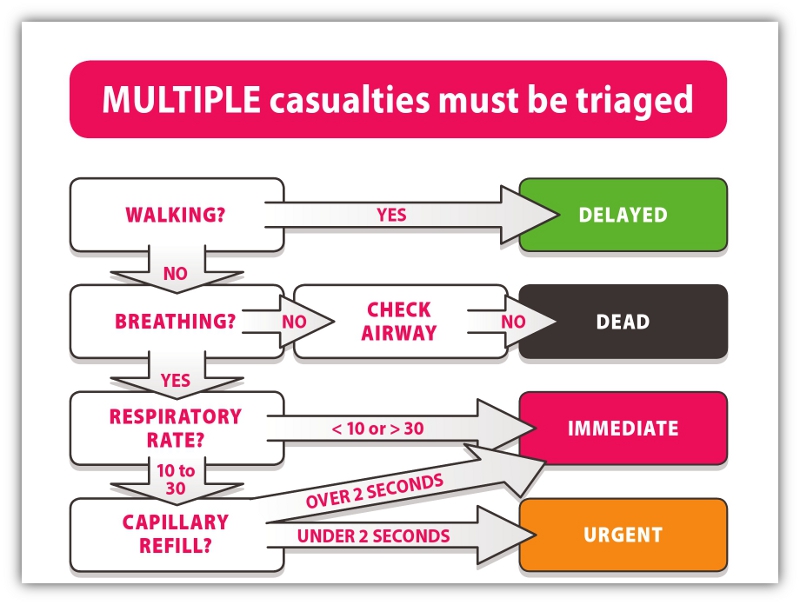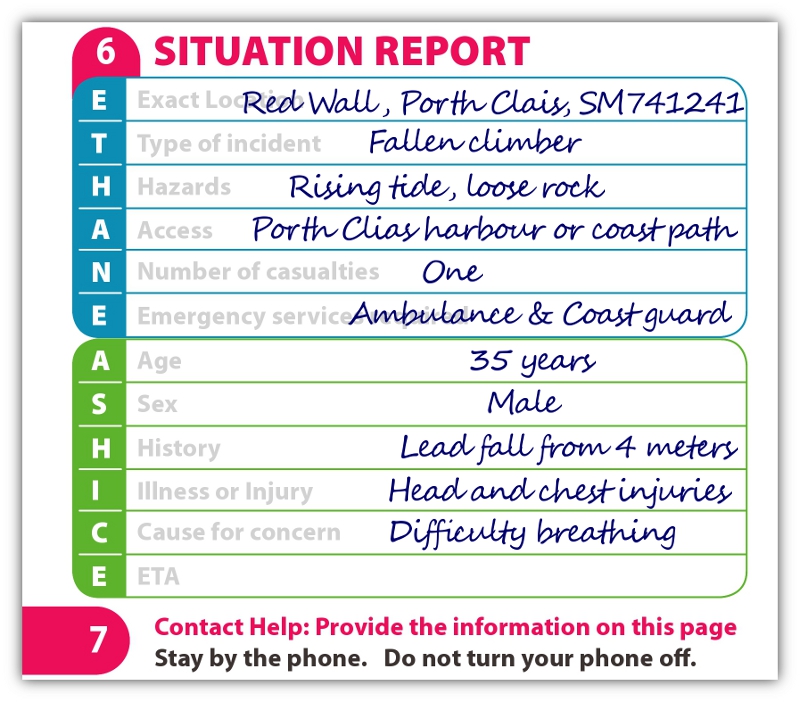The REAL First Aid Casualty Card Instructions
Start Here:
Do you have ONE casualty or MULTIPLE casualties? If you only have one, move on the next stage.
If you have multiple casualties, use the triage algorithm to prioritise the order of treatment.
Further Reading: Triage
REMEMBER: Triage is objective and systematic. Triage has nothing to do with the casualty's injury or whether they are conscious or not. Ask yourself "Are they walking? Are the Breathing? Is it Normal?"
Now you have identified the casualty who needs treating first...
Are they conscious or Unconscious?
The need to differentiate determines whether you can ask them questions or not. If they are conscious, ask them the Questions over the page. Ask them before they go unconscious.
If they are not conscious, start your Primary Survey.
Questions
These two mnemonics are prompts to important questions about what happened and they type of pain they may be suffering.
Further reading: Questioning SAMPLE
Further reading: Questioning PQRST
WRITE EVERYTHING DOWN. It might not be make sense or seem important to you but they will to someone else when you go to get help and handover the casualty.
Primary Survey
If your casualty is conscious - still record the primary survey: They may have been talking to you but are they ALERT or simply responding to your VOICE?
They may be breathing, but HOW are they breathing?
You may be able to record accurate, quantitative data if you have the diagnostic tools such as a BP cuff, thermometer, or pulse oximetry but even if you don't, record whether the signs you can detect are stable or unstable:
Are they getting hotter or colder?
Are they going pale or staying normal?
What is most important is recording any change over time.
Further reading - Vital Signs
Further reading - Pulse & Sp02
Further reading - Blood pressure
Secondary Survey - "Damage"
Use this chart to:
Record the location and nature of injuries
Estimate burns as a percentage of body surface area
Remember when calculating burns percentages, the torso is split into upper and lower halves on front and back. Limbs count as complete limbs:
In this example the casualty has superficial burns to the whole of his left lower leg but only the front of his right lower leg so his estimated burns would be 9% + 4.5% = 13.5%
Do you call for help or send a messenger?
If you are alone with the casualty you may need to leave them to get to a phone or find signal. If you have a messenger, tear the casualty card in half.
The messenger can take their half with them to an area of radio or mobile phone reception but you keep your half for recording vital signs back in section 3 - "Primary Survey".
Situation Report
Before contacting help - or sending the messenger - complete the remainder of the form with all the relevant information. This page of the reporting card provides all of the necessary information required for contacting help.
If you are contacting the civilian Emergency Services they will ask a strict set of questions based on their reporting software. The information they require will be on the incident form, but not necessarily in this order.
If you are relaying information to a base command you can provide it in a more structured or conversation manner.
In the example above, it may sound something like:
"I have a 35 year old male who has suffered a fall from height whilst climbing. I need Ambulance and Coastguard to Red Wall, Porth Clais, SM 741 421.
There is difficult access with a rising tide below and loose rock from above. the best access will be from the water or a protracted walk in via the coast path.
The casualty has obvious head and chest injuries but my concern is his difficulty breathing"
Can you give me an ETA?"
Together with any information gleaned earlier on from SAMPLE and PQRTS if the casualty was conscious.
What next?
Continue to record vital signs - Recording vial signs becomes more important the longer your casualty is from help. This page becomes the most important record to handover when help arrives.
If you do not think the casualty requires emergency treatment but should seek professional medical advice, get them to sign the box at the bottom of the back page to confirm that
You have suggested this
They have accepted this advice
'If you don't write it down, it didn't happen'








